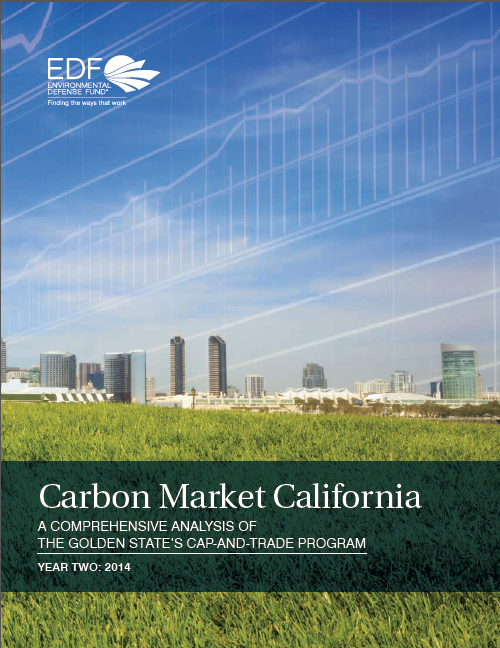Note: The original post has been edited slightly to clear up a misconception. Companies subject to the emissions cap cannot pay for the right to exceed the cap.
The Environmental Defense Fund released a report this morning that says the second year of California's cap-and-trade program is a success on several fronts.
The report, “Carbon Market California Year Two” [PDF], follows up on its first-year report by analyzing results from the 2013-14 cap-and-trade program.
Cap-and-trade is the part of California's climate change law that puts teeth into the state's efforts to reduce greenhouse gas emissions. It works by defining an upper limit, or “cap,” on emissions for different industry sectors, and creating credits per ton of carbon pollution.
Companies are allowed a certain number of “free” emission credits, and a limited number are also made available for auction -- thus the “trade” part, wherein companies buy and sell credits amongst themselves. The total number of available credits, free and auctioned, equals the industry-wide emissions cap.
The cap is set to shrink over time as the state moves towards its carbon emission reduction goals, thus requiring companies to further reduce emissions. At the same time, the price of emission allowances will rise as competition for them becomes hotter, and the more a company can reduce its emissions the fewer credits it will need.
Revenues from the auctions are to be used for projects that can help the state further reduce emissions, for example by building affordable housing near transit, although raising money is not one of the goals of the program.
According to the report, California is succeeding in limiting, pricing, and reducing emissions by getting industries to pay for the pollution they produce.
Key conclusions from the report after the jump:
- Despite dire predictions that cap-and-trade would destroy California industry, the state's economy is thriving, and the number of jobs is growing, even faster than in the rest of the country. This is especially true in the green tech sector, where the job growth rate, at five percent, was even higher than the statewide average. It is a small portion of the economy, but these are early days.
- Emissions that are subject to the cap are decreasing, mostly from declining emissions in the energy sector as electricity producers shift to cleaner, renewable sources—including electricity from outside the state. (How close that gets us to state goals is a whole 'nother discussion). Emissions from sectors not subject to the cap last year, including transportation fuel suppliers, went in the opposite direction, increasing slightly—yet another argument against efforts to delay bringing them into the program.
- The carbon market is healthy, with stable prices and active participation. “The result of the nine quarterly auctions through November 2014 demonstrate that companies are taking this program seriously and factoring a carbon price into their business strategies,” according to the report. An active secondary market wherein state-approved offset credits are traded has also shown stable prices, reflecting “confidence, familiarity, and participation in the market.”
- California industries are complying with the program. All of the companies subject to the cap have complied with requirements to report their emissions and surrender credits by the first deadline, “demonstrating that entities are omitted to complying with the program and are aware of what is expected of them moving forward.”
- While the programs that invest money raised from cap-and-trade are in their early stages, they hold promise for producing greenhouse gas emission reductions in ways that the state otherwise would not have been able to encourage or force, for example by promoting transit-oriented development.
- Fears that California is trying to solve a global issue alone are allayed by the international interest being shown. California's cap-and-trade system has already formally linked its program with one in Quebec, holding a successful joint auction of credits held last fall. California has signed agreements with Mexico, Peru, Israel, and China to share information and lessons learned about emissions trading programs, and joined the Pacific Coast Collaborative with Washington, Oregon, British Colombia to pursue common policy approaches to climate change.
In addition to details about these points, the report contains interviews with a number of economic and climate change policy experts from around the world.
Email tips, alerts, press releases, ideas, etc. to melanie@streetsblog.org.
For social media coverage focused on statewide issues, follow Melanie @currymel on Twitter or like our Facebook page here.







